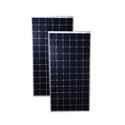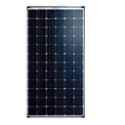Translate:
Types of Solar Panels and their Features
Solar Panels, as we all know, have become quite trendy these days. People usually install them to save on their electricity bills. Scientifically a Solar Panel is equipment used to absorb the solar energy emitted from the sun and then convert it into electricity, which can be further consumed normally.
Typically, Solar Panels are composed of solar cells, which are made of different elements, which include silicon, boron, and phosphorus. The boron layer is responsible for providing a positive charge, the phosphorus layer is negative, and the silicon layer acts as a semiconductor. In simple words, a solar panel is a combination of photovoltaic cells arranged in a framework that is used to trap the solar energy and then convert it to energy used for electricity or heating. This energy can be used as electrical energy with the help of an Inverter.
You will majorly find three different types of solar panels in the market, here is a list of the same.
Monocrystalline Solar Panels:
A solar panel made out of monocrystalline solar cells is known as a monocrystalline solar panel. These cells are mainly manufactured from a cylindrical silicon ingot that is formed in the same way as a semiconductor from a single crystal of high purity silicon. The cylindrical ingot is split into wafers, which are then assembled into cells. The circular wafers are actually wire cut to an octagonal shape to enhance the utility of the cells. Because of their octagonal shape, these cells have a distinct appearance. The color of these cells is also consistent.
Monocrystalline solar panels are one of the three types of photovoltaic materials available. Amorphous or Thin-film solar panels are one and the other is Polycrystalline solar panels. Monocrystalline solar panels are said to have advantages over the other two varieties.
Some of the unique features and advantages of Monocrystalline solar panels are as follows:
- The pyramid arrangement of these cells on the panel provides a bigger surface area for collecting more energy from the sun's rays.
- The top surface is phosphorus diffused, which serves to create an electrically negative orientation as opposed to that at the bottom, which has a positive electrical orientation and which helps to create the electric field.
- The cells are coated with silicon nitride to reduce reflection and hence maximize absorption.
- Metal conductors printed onto the cells gather the generated electricity.
- Because of the aforesaid characteristics, monocrystalline solar cells have a better conversion efficiency of solar energy into electric energy than their two other counterparts.
- These panels have a 30-year lifespan.
- These panels are more resistant to heat.
Top Sellers

Solar Universe 400W 24V Monocrystalline Solar Panel, SUI-400 (Pa ...
₹4400023% OFF₹29865

Birkan 400W 24V Monocrystalline Solar Panel, Birkan-400
₹1900010% OFF₹15133
Polycrystalline Solar Panels:
Solar panels that contain many silicon crystals in a single PV cell are known as PolyCrystalline or MultiCrystalline. Polycrystalline solar panels are made up of wafers made up of many silicon fragments fused together. The molten silicon vat used to make the cells in polycrystalline solar panels is allowed to cool on the panel itself. The surface of these solar panels resembles a mosaic.
These solar panels are square in shape and have a gleaming blue tint due to the fact that they are made up of numerous silicon crystals. Polycrystalline solar panels allow less mobility of electrons inside the cells because each cell has many silicon crystals. The sun's energy is captured by these solar panels and converted into power.
The main features of Polycrystalline solar panels are as follows:
- These Polycrystalline solar panels are comparatively more environmentally friendly than monocrystalline solar panels since they do not require the individual shape and placement of each crystal, and the majority of the silicon is used during the manufacturing process. As a result, relatively little waste is generated.
- The maximum temperature for polycrystalline solar panels is 85 degrees Celsius, and the minimum temperature is -40 degrees Celsius.
- The heat tolerance of polycrystalline solar panels is lower than that of monocrystalline panels. As a result, these solar panels are less efficient at higher temperatures than others.
- The temperature coefficient of polycrystalline solar panels is larger than that of monocrystalline panels.
- They come with their own structural frame, which makes installation cheaper and easier.
- The power density of these panels is very high.
Thin Film Solar Panels:
An assemblage of thin-film solar cells makes up a Thin-film solar panel. The photovoltaic effect is used to convert solar energy to electrical energy in these solar panels. Each photon-absorbing layer in a thin-film solar cell is made up of many layers. These layers can be 300-350 times smaller than those seen in traditional silicon panels.
The material that is employed as a substrate in these solar panels is used to categorize them. Amorphous Silicon (a-Si), Copper Indium Gallium Selenide (CIGS), Cadmium Telluride (CdTe), and Gallium Arsenide (GaAs) are some of the substrate materials employed. Thin-film solar panels with a GaAs substrate are the most efficient, with an efficiency of 28.8% more than the others.
The most prominent features of Thin-film solar panels are as follows:
- Thin-film solar panels are lightweight and flexible.
- These panels are much easier to install and require significantly less labor than typical silicon panels.
- As they contain a relatively small amount of silicon, the emissions produced during their manufacture are also very low when compared to the emissions produced during the manufacture of ordinary solar panels.
- These are simple to install due to their small weight.
- These solar panels are best suited to applications involving vast rooftops or open areas.
Conclusion:
Solar panels are now in trend and are used in various places for varied purposes. Now that you know the three main types of solar panels and their features, you will be able to decide on what you want according to your requirements. Well, make sure to inspect the brand and warranty of your product. At Moglix you will find an amazing range of solar panels which are acquired from the trusted supplies.




